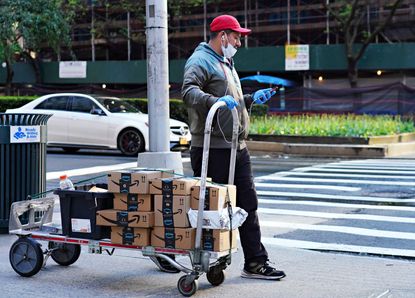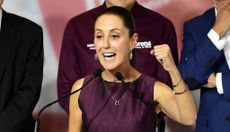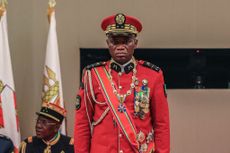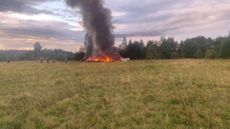Worry about contact with people, not objects, CDC advises in coronavirus guidelines


The Centers for Disease Control and Prevention prominently warns on its "How COVID-19 Spreads" page that "the virus spreads easily between people." But it also says, in new language, that "the virus does not spread easily in other ways," including "from touching surfaces or objects," The Washington Post noticed Thursday.
"It may be possible that a person can get COVID-19 by touching a surface or object that has the virus on it and then touching their own mouth, nose, or possibly their eyes," the CDC says. "This is not thought to be the main way the virus spreads, but we are still learning more about this virus." CDC spokesman Kristen Nordlund told the Post the quietly updated guidance came from an internal review and "usability testing," but did not represent a change in how the CDC describes transmission. Previous versions of the site did have similar language, the Post reports.
The coronavirus can remain potentially viable on cardboard for up to 24 hours and up to three days on plastic and metal, virologist Vincent Munster and his colleagues at the National Institute of Allergy and Infectious Diseases lab in Hamilton, Montana, found. But it usually breaks down within hours of leaving its host. "Direct contact with people has the highest likelihood of getting infected — being close to an infected person, rather than accepting a newspaper or a FedEx guy dropping off a box," Munster told the Post.
Subscribe to The Week
Escape your echo chamber. Get the facts behind the news, plus analysis from multiple perspectives.

Sign up for The Week's Free Newsletters
From our morning news briefing to a weekly Good News Newsletter, get the best of The Week delivered directly to your inbox.
From our morning news briefing to a weekly Good News Newsletter, get the best of The Week delivered directly to your inbox.
If not living in fear of Amazon deliveries is the good news, the bad news is people are starting to venture into public spaces again, not always observing social distancing. The U.S. is on the cusp of 100,000 COVID-19 deaths, and if just 30 percent of people return to pre-COVID life, that number will easily surpass 200,000 by the end of summer, Nina Fefferman, who models diseases at the University of Tennessee, Knoxville, tells Politico.
Create an account with the same email registered to your subscription to unlock access.
Sign up for Today's Best Articles in your inbox
A free daily email with the biggest news stories of the day – and the best features from TheWeek.com
Peter has worked as a news and culture writer and editor at The Week since the site's launch in 2008. He covers politics, world affairs, religion and cultural currents. His journalism career began as a copy editor at a financial newswire and has included editorial positions at The New York Times Magazine, Facts on File, and Oregon State University.
-
 The hunt for Planet Nine
The hunt for Planet NineUnder The Radar Researchers seeking the elusive Earth-like planet beyond Neptune are narrowing down their search
By Chas Newkey-Burden, The Week UK Published
-
 Magazine interactive crossword - April 26, 2024
Magazine interactive crossword - April 26, 2024Puzzles and Quizzes Issue - April 26, 2024
By The Week US Published
-
 Magazine solutions - April 26, 2024
Magazine solutions - April 26, 2024Puzzles and Quizzes Issue - April 26, 2024
By The Week US Published
-
 Puffed rice and yoga: inside the collapsed tunnel where Indian workers await rescue
Puffed rice and yoga: inside the collapsed tunnel where Indian workers await rescueSpeed Read Workers trapped in collapsed tunnel are suffering from dysentery and anxiety over their rescue
By Sorcha Bradley, The Week UK Published
-
 More than 2,000 dead following massive earthquake in Morocco
More than 2,000 dead following massive earthquake in MoroccoSpeed Read
By Justin Klawans Published
-
 Mexico's next president will almost certainly be its 1st female president
Mexico's next president will almost certainly be its 1st female presidentSpeed Read
By Peter Weber Published
-
 North Korea's Kim to visit Putin in eastern Russia to discuss arms sales for Ukraine war, U.S. says
North Korea's Kim to visit Putin in eastern Russia to discuss arms sales for Ukraine war, U.S. saysSpeed Read
By Peter Weber Published
-
 Gabon's military leader sworn in following coup in latest African uprising
Gabon's military leader sworn in following coup in latest African uprisingSpeed Read
By Justin Klawans Published
-
 Nobody seems surprised Wagner's Prigozhin died under suspicious circumstances
Nobody seems surprised Wagner's Prigozhin died under suspicious circumstancesSpeed Read
By Peter Weber Published
-
 Western mountain climbers allegedly left Pakistani porter to die on K2
Western mountain climbers allegedly left Pakistani porter to die on K2Speed Read
By Justin Klawans Published
-
 'Circular saw blades' divide controversial Rio Grande buoys installed by Texas governor
'Circular saw blades' divide controversial Rio Grande buoys installed by Texas governorSpeed Read
By Peter Weber Published